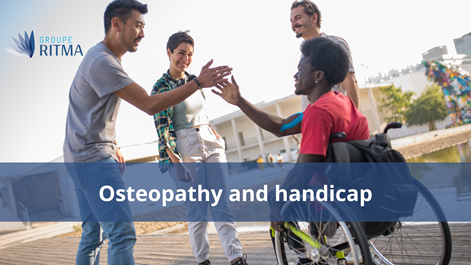
Chronicles
27 June 2023
Osteopathy and Disability

We all want to stay healthy for as long as possible, whether we have a disability or not. We all want to make the most of our body's resources and age well. Osteopathy, in particular, is a frequently requested approach to optimize our well-being.
In Quebec, there are currently 1,053,350 people aged 15 and over in Quebec who have at least one disability. This is 16.1% of the population aged 15 and over living with a disability. Despite this reality, disability often remains a poorly understood topic with limited resources. However, osteopathy can bring many benefits when it is adapted to the specific condition of each individual.
So how can osteopathy be a beneficial approach to relieve symptoms and improve the quality of life of people living with a disability? Here are some leads:
The techniques used in osteopathy are what are called soft tissue techniques. They are precise and targeted. The osteopath has different techniques, ranging from cranial techniques to muscular techniques, including visceral techniques. The objective is to restore the functioning of the systems and restore mobility to help customers better live with their disability.
Osteopathy offers precise and targeted techniques
What forms of disability can osteopathy address?
There are forms of disability with visible or invisible manifestations. Each individual is unique, as is each client, and osteopathy has the flexibility, with its holistic approach, to adapt its techniques accordingly. The osteopath has a variety of techniques to work and bring some comfort by targeting the muscle chains.
The concept of disability encompasses a diversity of situations and conditions, and can include a large number of people, such as those who have suffered an accident, a head injury, those who are in a wheelchair, bedridden or facing behavioral problems. Each disability has unique characteristics.
Like everyone else, people can suffer from so-called "functional" pain, that is to say pain that does not originate from a lesion of the structure or organ, but rather from an imbalance in relation to its normal functioning. On this type of situation, osteopathy has a wide field of action.
Several parameters that can be linked to the disability can accentuate this type of symptom, such as:
- Physical deformities linked to pathology, these increase the stresses on certain areas of the body and can create musculoskeletal disorders (MSDs) such as back pain and lumbar tension.
- Organic or structural damage which, by altering the structure and functioning of certain organs, can create local and remote tensions in these organs.
- In some cases, the disability is the consequence of a trauma (such as an accident for example) or of the installation of tensions over time, tensions which can accumulate and lead to more intense pain and this can also cause blockages which over time can cause pain.
Osteopathy can benefit people with disabilities, helping to improve their comfort, mobility and overall quality of life.
In the treatment and prevention of musculoskeletal disorders and bodily dysfunctions for people with disabilities, osteopathy can offer several advantages:
Relief of discomfort: People with disabilities can often experience muscle tension, joint misalignment or posture problems. An osteopath can use manual techniques to improve these conditions.
Some disabilities can limit mobility and lead to joint stiffness or loss of flexibility. Osteopathy can help restore joint and soft tissue mobility through gentle manipulative techniques.
Some people may have breathing problems related to their condition. Osteopathy can help improve respiratory function by releasing tension in the muscles and structures surrounding the lungs and diaphragm.
People with disabilities can experience high levels of stress due to the physical and emotional challenges they face. Osteopathy can promote relaxation, reduce anxiety and help improve overall well-being.
Osteopathy and well-being
Osteopathy contributes to the well-being of individuals with disabilities by releasing the blockages and tensions of certain muscle chains.
It is important to emphasize that the role of the osteopath is not to eliminate the disability in itself, because that is not the responsibility of the therapists. However, providing judicious support to people with disabilities, helping them to live better with their limitations on a daily basis is one of the possible beneficial actions. The objective is to improve the comfort and quality of life as far as possible to provide additional comfort to the person.